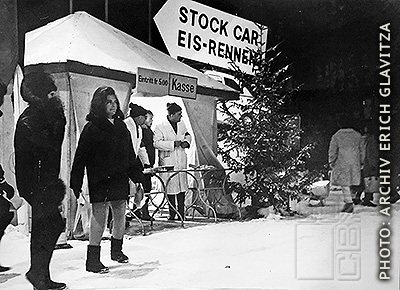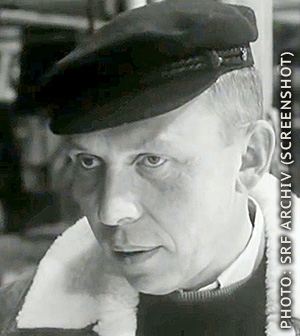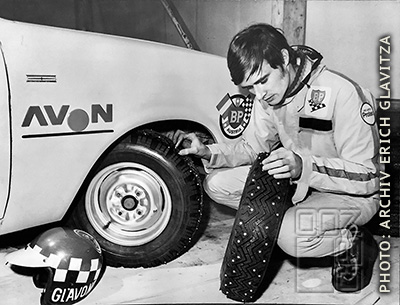Driving Miss Tracy – The Erich Glavitza CBn Interview Part 1

A few years ago, Bond expert Charles Helfenstein asked me to be his translator on a trip to Switzerland where he wanted to research for his forthcoming book “The Making of ‘On Her Majesty’s Secret Service’”. One day we were standing on a meadow outside Lauterbrunnen, trying to find the exact location where the ice racing scenes were shot. He told me that he had interviewed so many people who had worked on the film, but that he was unable to find any of the drivers who were involved in the shooting of that ice race. And it still was that way when the book was finally published (and much lauded) in 2009.
Fast forward to 2019. The German fan club James Bond Club Deutschland (of which I’m a board member) has a special guest on it’s annual meeting. One Dr Erich Glavitza, author of a recently published book “Vollgas oder Nix! – Meine wilden 60er mit Rindt, James Bond und McQueen” (Full Speed or Nothing! – My Wild Sixties with [German-Austrian F1 driver Jochen] Rindt, James Bond and McQueen). Back in 1969, he was the head of a group of young Austrian racing drivers who drove in those ice racing scenes. He told many stories from the shooting of OHMSS, answered questions and signed books and autographs. He later joined us for dinner were I was lucky to be seated close to him.
He recounted many more anecdotes, not only from OHMSS but also Steve McQueen’s “Le Mans” movie for which he was a stunt driver and even played a small role. As he’d been well connected in the international racing scene since the early sixties, there were a lot of Formula One stories, too.
His book is (currently) only available in German, so I asked him for an interview for an English Bond fan site (this one) to make his account accessible for the international Bond fan community. He agreed, also to my idea that in order to save time and effort I’d make rough (and abridged) translations of his book and the stories he told on that day to create sort of an interview. Of course I also asked some additional question which he was happy to answer. This one’s for you, Charles.
Erich, in your book, you write that the call from James Bond not only turned your life around 360 degrees but put you on a carrousel going at the speed of sound. What happened?
Let me give you some background information first. I’ve been a racing enthusiast for all my life. Even when I was just driving my mother’s old Volkswagen, it had to be at full speed, always braking at the last possible moment. I’d made a few contacts in the Austrian racing scene, which wasn’t very big in the early 60s, mostly rich kids from Vienna. My schoolmate Peter Huber and I had the dream of going to England, learn how to build a proper race car and eventually become famous racing drivers. It took us quite some time to learn that things worked a bit different than how we thought they would.
I became a journalist and soon specialized in motorsports. The international racing scene wasn’t a closed shop as it is nowadays, getting to know people was fairly easy. It was no problem to approach famous drivers and constructors like Jim Clark, Bruce McLaren or John Surtees, ask questions – and get proper answers. My friendship with German-Austrian racing driver Jochen Rindt certainly helped a bit.
But you were a racing driver yourself, as well?
I also took part in rallies, local sports car races and even in Formula Vee. I gained a reputation as a sometimes a bit reckless driver. There had been an incident at the 1968 “Danube-Castrol-Rally” in Romania that involved a Citroen DS 21, an unlighted railway crossing and a steam locomotive. Peter and I barely got out alive, but this more or less lead to my involvement into OHMSS.
How come?
I walked into the editorial office one morning, and one of our football writers said to me “Hey Erich, James Bond called for you, the number’s on your desk” – “James Bond? Why not Jesus? Rubbish.” I looked at the number – it was from Switzerland. I thought that the call might have been from Swiss driver Jo Siffert. But my call back was answered by a female voice “So-and-so Productions, one moment, please.” The next thing I heard was a male voice, loud, burly, “Sergeant” type: “Herr Glavitza?” – “Yes, that’s what I just said.” He started telling me about a movie production, a new James Bond movie, in Lauterbrunnen, Switzerland. They were planning for a car racing scene in the movie, which involved a car crash and asked if I was capable of overturning a car. I cheekily asked back: “How many times d’you want it?” – “Okay, can we call you back tomorrow?” Of course they could.
And they really did?
Else we wouldn’t be talking now (laughs). He called back the next morning and introduced himself as production manager Hubert Fröhlich, a German. He soon went into detail, asked this and that and told me that they’d need five cars for about a week. Finally, he asked about my fee. At the spur of the moment, I said “One thousand British pounds, all inclusive.” – “All inclusive?” – “Cars, drivers, transport, accommodation, everything.” I told him that I’d be available in four weeks, as I had to drive a rally in Portugal first.
How did he get the idea to call you, of all people?
That’s what I asked him, too. Back in those days, there weren’t many real expert stunt drivers available as we have them today. Stunt people rode horses, jumped from buildings or did fistfights, but they rarely were skilled drivers. He told me that he’d contacted the editor of the German “Rallye Racing” magazine and asked if he knew some madman who’d be able pull off a few car stunts. Now, that guy had witnessed that locomotive accident in Romania and apparently investigated a bit about me after that. When Fröhlich asked him, he answered without thinking for a second “Call that Glavitza guy in Vienna.”
So, you went to Lauterbrunnen four weeks later…
After finishing that rally, I drove straight to Lauterbrunnen – in the rally car, alone, as my co-driver had urgent business in Vienna and had already gone home by plane. I barely got any sleep for three days, only stopped every once in a while to get some sandwiches. Must have stunk like a lion’s cage in that car. As soon as I was there, I took the cable car up to Mürren where Fröhlich had his office in the cable car station. He handed me a copy of the OHMSS novel which I should read and ordered me to come back the next day and tell him about my ideas.
They’d booked me into the Alpine Palace Hotel, and boy, it really was a palace, with heavy curtains around the bed and gilded taps in the bathroom. That was quite something for a poor guy from Kapfenberg / Styria like me. I had to pinch myself several times. I flicked through the novel while taking a bath and wanted to take some notes after that, but I fell asleep in that fleecy white bathrobe as soon as I hit the bed and slept like a log until the next morning.
But you did have some ideas when you met Fröhlich the next morning?
Of course. I’d had four weeks to think about everything before that. I was thinking about a race track on ice or snow on one of the meadows down in the valley, with a small race with about five cars going on. James Bond would enter the track from outside somehow while being pursued by the bad guys. The pursuit would continue on the track with the other cars involved, there’d be shooting and lots of accidents and at the end, the bad guys’ car would overturn and explode.
And that’s exactly how it happened in the movie…
Yes, indeed. When I had finished my expalanations, Fröhlich repeatedly said “Boy oh boy”, lit another cigarette and said “Okay, lets go over to Mr Saltzman and tell him about it.” I tried to explain that I had lots of work before me and needed to hurry home as quick as possible, look for cars and drivers and everything. “Who is this Saltzman guy and why do we need him? I thought you are the production manager…”
You had no idea who he was?
No, not at all. I was a motorsports guy and didn’t have that much interest for movie people. Fröhlich became furious, with a dark red face he started shouting “This Austrian guy with the shabby coat and holes in his shoes wants to know who is this Saltzman guy, good grief! Harry Saltzman currently is the wealthiest movie producer in the world and he’s paying for all this. Don’t you ever ask again ‘Who is this Saltzman guy?’” I thought I’d better follow him.
I started explaining again, with lots of gesturing and waving around with my arms. Saltzman just nodded, looked at Fröhlich, looked back at me, nodded again, then he interrupted me and said: “Okay Erich, let’s see what we can do.” He grabbed his telephone, gave some orders and when we came outside, there was an Agusta helicopter waiting for us. Just minutes later, we stood on a muddy meadow down in the valley near Lauterbrunnen, sticking twigs and branches into the ground to outline the race track. I explained how I imagined the stunts and the camera position, again gesturing wildly. Saltzman looked at his mud soiled tailored shoes, laughed and gave me a pat on the back. “Good job, son.” he said.
Wow, that went pretty quick.

before the shooting began. The cars
are still in pristine condition.
As I said, like a carrousel going at the speed of sound. I could barely catch my breath. While driving back to Vienna, I asked myself if all this could be true. At the same time, I started making plans and thought about cars and drivers. Myself, I had a modified Mini and my mother’s Volkswagen, a friend had another Mini and two other friends also had Beetles. But when I was back in Vienna, I soon got a call that Saltzman wanted the race bigger, with about ten cars, and that the shooting would take at least two weeks, if not three. I started doing the maths. One car was thousand pounds per week, ten cars for three weeks… One pound was 65 Austrian Schillings at that time. I didn’t even dare to say the numbers aloud. With the money I currently had in my pocket, I was barely able to pay for the coffee I just had at the café.
But you had a lot of work ahead of you for that. How did you get the other cars?
Jochen Rindt had introduced me to Walter Hayes a while ago. He was one of the bigwigs at Ford of Europe at the time and one of the driving forces behind Ford’s racing ambitions. I gave him a call and explained about James Bond, the ice race and that I wanted to use Ford Escorts. All he asked was “How many cars?” I became bold and said that I’d probably need between ten and fifteen cars, upon which he replied “No problem, Erich.” He wanted me to come to England as quick as possible and talk about the details. I had to spell my name and he told me to pick up my ticket at the BEA Vienna office the next morning.
The next day, I was picked up in Heathrow by a chauffeur who brought me to Hayes’ office in Brentwood. After I had explained everything in detail to him, Hayes said: “Okay, you can have as many cars as you need. If you need anything else, here’s a phone number, you can call me directly, day and night.” I asked if it would be possible to get the cars from Ford’s Salzburg entrepôt as it would spare me lots of time and effort (and money) if I didn’t have to transport the cars from England to Austria. “Yes of course” he said “I’ve been thinking about this, too. I’ll instruct Ford-Austria to give you as many cars as you want.”
Incredible. Today, something like this would take weeks of meetings and negotiations and would end up in a huge and much lauded sponsorship deal, involving tie-in promotions and large amounts of money.
Yes. It may sound strange, but deals like that more or less didn’t exist at the time. F1 race cars weren’t even allowed to have advertising on them. To give you an example: a few years ago, upon a visit on his farm in Scotland, I had asked Jim Clark how much he got for the permission to put his trademark JC initials on these beautiful and rather expensive racing gloves (which I liked a lot but couldn’t afford). He asked back: “What do you mean, how much?” “Dollars”, I said. I was expecting a 5-digit number. He laughed and said “Ten pairs of gloves.” Later that night, I found a pair of these gloves on my bed. He really was a great guy.
But back on Bond… The next thing I needed was tyres. This was going to be a race on ice which required special tyres with spikes. I had had a brief involvement with AVON tyres related to a rally project a while ago and I had the number of their London headquarters, so I called them up. They were better known for motorcycle tyres at the time and tried to get into the car tyre market. They were taken to the whole thing right away and offered full support.
For the spikes, I contacted a rally mate in Sweden who worked for Scarson, a spike manufacturer. Again, I offered exclusivity, advertising stickers on the cars and all that stuff, and again, I got what I wanted. I had calculated 1.200 spikes per tyre. In the end, we had 25 cars and with four tyres per car, we needed 120.000 spikes to be shot into the tyres. This was done in Zurich, where the tyres had been delivered to Swiss tyre importer Frey. The guy who did the spiking ruined his tendons and had to have his arm put in a cast. As a compensation, I later invited him and his family to a set visit in Lauterbrunnen.
Finally, we needed safety belts, which weren’t standard equipment in most cars at that time. I contacted an old mate who was head of PR for the Austrian Tyrolia company. Their main business were ski bindings, but they also manufactured safety belts. The deal was settled in the usual way and the belts were mounted. By that time, we had ten Escort 1100s, two Minis and one Beetle. Later there would be another 12 Escorts.
You certainly had to think of thousand things and more. Did you even find time to take care of the track itself?

The box office at the entrance shows the
admission fee for the race: 5 Swiss Francs.
The track was built by EON’s people – they knew what they had to do. After I settled the deal with the tyres in Zurich, I went to Lauterbrunnen with a rental car to test the ice track. It had been well prepared with ice resurfacers they had borrowed from the Interlaken ice hockey club. But the tyres on that car were only spiked for regular traffic use, so it was impossible to pick up the necessary speed and drift properly. The EON people were a bit disappointed. I’d have to bring two of the fully equipped cars and show them the real thing. A couple of days later, me and one of the other drivers took two of the Escorts to Zurich where we picked up two sets of spiked tyres and then went on to Lauterbrunnen. We made two or three slow laps to roughen up the ice a bit and give it some grip. The movie people had gathered around the race track. I could still see some disappointment in their faces. I guess they thought that this was all we could do.
And then we kicked it off. We shifted back into second gear and let loose. The grip of the tyres was sensational. The spectators were scared shitless immediately. We were drifting within a distance of only a few inches from the side fences, chunks of ice getting thrown in their faces. We got all worked up and almost overdid it, so we stopped before we shot ourselves to hell. Production assistant Jack called up Fröhlich in Mürren, shouting with excitement “Thousand percent improvement – these guys are absolutely crazy.”
End of part One –
Don’t miss part Two, in which you’ll read about rehearsals,
teaching Diana Rigg how to drive on ice …and garlic.
Feel free to discuss this article in our forum:
quarterdeck.commanderbond.net
Erich Glavitza
Vollgas oder nix –
Meine wilden 60er mit Rindt,
James Bond und Steve McQueen
McKlein Publishing, 288 pages, German
ISBN 978-3947156115, 34.90 Euro
Special thanks to Doug Redenius from the Ian Fleming Foundation and Ajay Chowdhury




